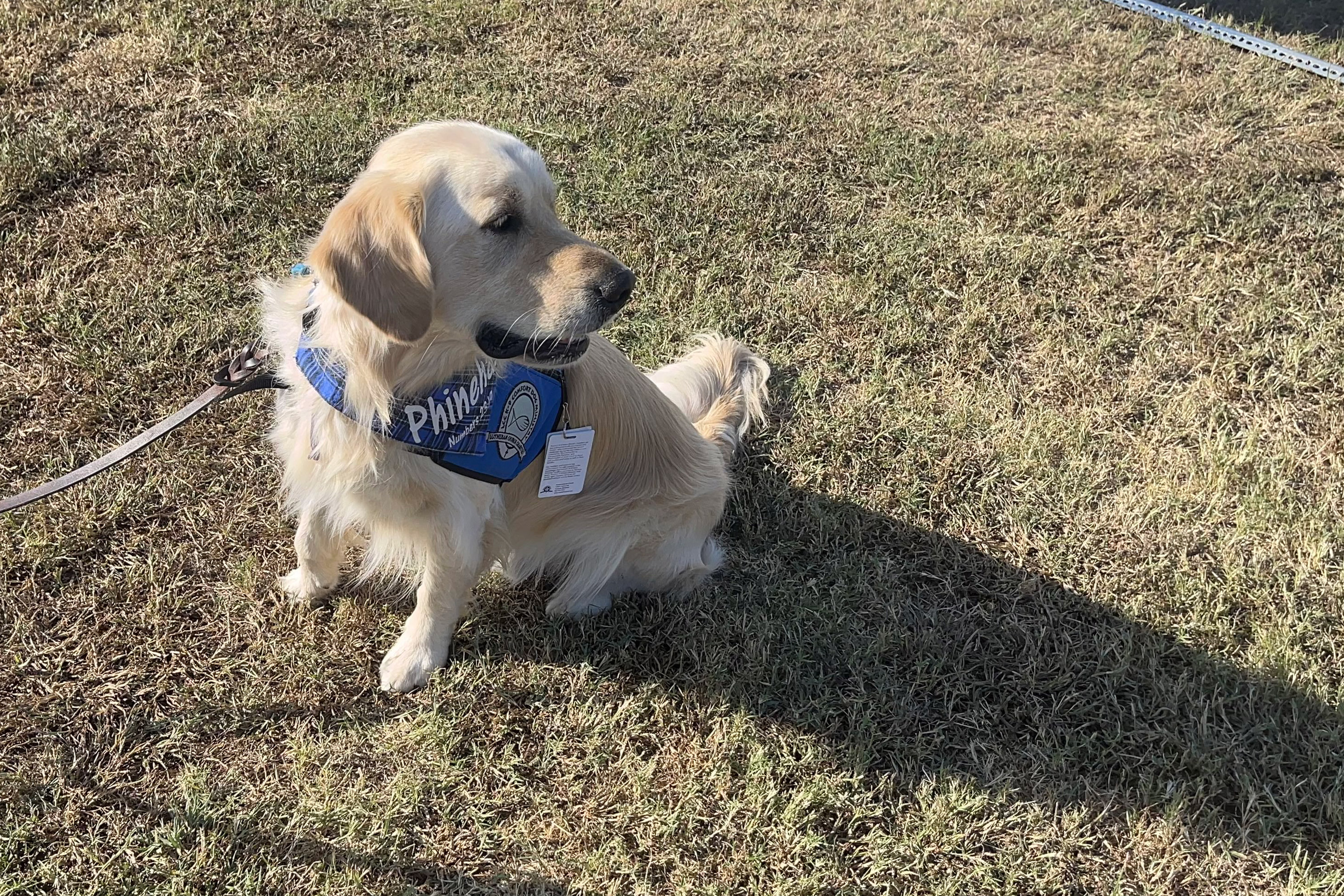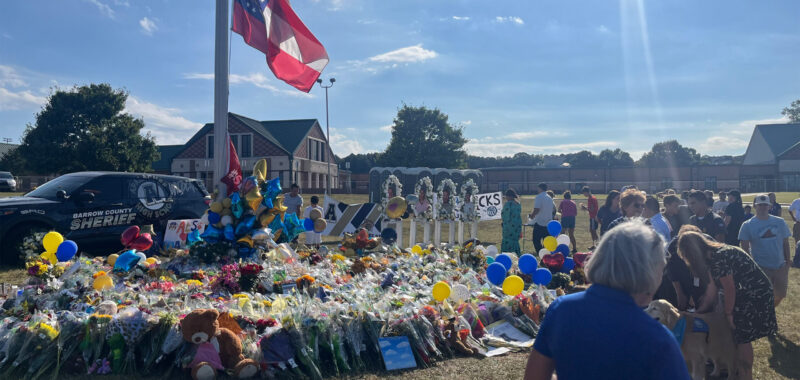WINDER, Ga. — About an hour after gunfire erupted at Apalachee High School, ambulances started arriving at nearby Northeast Georgia Medical Center Barrow with two students and two adults suffering from panic attacks and extreme anxiety, not bullet wounds.
A fifth patient with similar symptoms later arrived at another local facility, according to a health system spokesperson.
The day after the Sept. 4 school shooting that killed two students and two teachers, some 80 families showed up in a county office to receive counseling from volunteer therapists who converged from across the Atlanta metro area, according to one medical provider. That Sunday, nine people received free treatment at a local church for post-traumatic stress disorder from volunteering Atlanta-area providers. On Monday, the state opened a temporary recovery center to help locals find counseling, faith-based support, or other aid. The needs are still great.
“We don’t really know how we’re doing,” Amanda McKee — whose son, Asa Deslonde, is a senior at Apalachee — said two days after the shooting. “It’s second by second. It’s minute by minute. The last couple days have been unimaginable.”

When shootings of any magnitude occur, they often leave the survivors with invisible injuries that can create life-changing symptoms that sometimes paralyze them.But such problems can take time to emerge. Panic attacks and anxiety can spike across a community after a shooting and can be most intense when people return to the scene, said Howard Liu, chair of the Council on Communications for the American Psychiatric Association.
So health providers worry that in the coming days, months, and years the community will struggle to find help for their mental health needs. Barrow County, along a highway that connects Atlanta to the college town of Athens, is a community where agriculture is steadily giving way to development.
Prior to the shooting, the area had one stand-alone inpatient mental health facility, located in Gainesville, about 30 miles away from where the shooting occurred in Barrow County, that was “constantly overwhelmed,” said Sean Couch, a spokesperson for Northeast Georgia Health System. And, the latest federal data shows, Barrow would need to add at least 13 full-time providers to no longer be considered a mental health workforce shortage area.
“We put a band-aid on a chronic situation and that band-aid isn’t going to last,” said Roland Behm, a co-founder of the Georgia Mental Health Policy Partnership, an advocacy group that represents mental health organizations in the state. “What happens three months from now?”
The scarcity of mental health providers in Barrow County is emblematic of the state as a whole. Georgia ranks nearly last among states in access to mental health care resources, according to Mental Health America, a nonprofit that advocates for increased mental health spending. More than 5 million Georgians live in mental health care professional shortage areas like Barrow County.
Paying for mental health care to treat such trauma is difficult nationwide. But Georgia is one of the 10 states that have not fully expanded eligibility for Medicaid, the nation’s safety net insurance for those with low incomes and also the largest payer for mental health services. The state has an uninsured rate of 13.6%, which is 4.1 percentage points higher than the country as a whole, according to 2022 data from the U.S Census Bureau.
Even people with private health plans have trouble finding affordable, in-network mental health care because of a lack of providers willing to accept low insurance reimbursement rates, Behm said.
Tamara Conlin, CEO of Advantage Behavioral Health Systems, said the people who came to the initial counseling sessions that her group helped arrange in a county office showed a lot of sadness and anxiety.
“Some of them are still in shock and trying to wrap their heads around what happened,” she said.
Even before the shooting, students at Apalachee High School reported significant mental health challenges.
Nearly 200 of 1,725 student respondents reported that they had seriously considered attempting suicide one or more times in the prior year, according to the latest Georgia Student Health Survey. Top motivators included problems with peers, friends, or family. About half of the students from the school who answered said they felt sad, depressed, or withdrawn at least once in the prior 30 days.
County residents complained about having to travel for psychiatric care and said the “shortage of psychologists and counseling services led to untreated high anxiety and depression rates,” during a 2019 focus group about health care access.
The lack of mental health care remained a top concern in the region during a follow-up assessment in 2022. That year, the opioid overdose death rate in Barrow County was among the highest in Georgia, according to state data, and the five-year suicide rate was above the state average.
The Barrow County School System, which includes Apalachee High School, received a $1.8 million federal grant to boost mental health resources in schools from 2023 through 2028.
But immediately following the shooting, mental health providers across the region still had to cobble together free resources for area residents. Three volunteers helped with last Wednesday’s response at Northeast Georgia Medical Center Barrow. Advantage Behavioral Health Systems kept its Barrow clinic open on Sunday and is providing counselors to community events and local schools as they reopen.
William Smith, who heads the Atlanta Center for EMDR, is planning sessions using eye movement desensitization and reprocessing therapy to address PTSD — at least one for first responders and another for residents.
Over the weekend, Lutheran Church Charities brought nine golden retrievers as “comfort dogs” to help the grieving. The group’s dogs have been deployed in the wake of other school shootings, including the Uvalde, Texas, massacre.

“We can’t fix what they’re feeling,” said volunteer Paul Soost, as people gathered around a campus flagpole where they delivered flowers and messages. “We can provide comfort.”
Many health care providers expect the community’s needs to spike when students return to Apalachee High School and as the national attention on the shooting recedes.
“That’s when people start experiencing the trauma,” said Conlin, with Advantage Behavioral Health Systems, who compared the current crisis to the surge of patients she saw after the immediate threat of the covid-19 pandemic passed.
Her clinic in Barrow County already had about 750 active clients before the shooting, with about 120 under the age of 18.
McKee said she knows healing will be a long process for her son, Asa. One of his football coaches, Richard Aspinwall, was among the four killed. A key step came the day after the shooting, she said, when the school’s head football coach convened the team to share how much he was hurting.
“The coach validated that they were hurt, and encouraged them to embrace that they were injured,” McKee said. “They’re not the physical injuries that were incurred by the senseless act, but they are injuries nonetheless.”
If you or someone you know may be experiencing a mental health crisis, contact the 988 Suicide & Crisis Lifeline by dialing or texting “988.”

